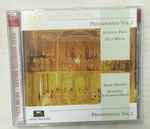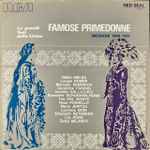
Ernestine Schumann-Heink
Austrian-born American operatic contralto (born June 15, 1861 in Lieben, Austrian Empire [today Libeň, part of Prague, Czech Republic] – died November 17. 1936 in Hollywood, California, USA).
Schumann-Heink was the most important alto, then contralto of her generation. Born Ernestine Rössler, the daughter of an Austrian cavalry officer, she grew up in Verona, Prague, Podgórze, and finally Graz, where she received voice lessons from a retired opera singer, Marietta von LeClair. In 1876, at age 15, she made her professional debut in Graz, singing the alto solo in Beethoven's "Ninth Symphony." Two years later, she appeared on stage as Azucena in Verrdi's "Il Trovatore," which she performed for four season's at Dresden's Royal Opera (Hofoper). In 1882, she married Ernst Heink, the secretary of the Semperoper in Dresden. Since the marriage violated the terms of their contracts, both were fired, and Ernestine moved on to Berlin's Kroll Opera. The next year, in 1883, she found a position at the Municipal Opera of Hamburg, where her husband had found a job as a customs inspector. Ernestine soon replaced the prima donna and remained in Hamburg for 13 years, during which time she had four children with Ernst. Both divorced in 1892, the same year in which she successfully performed Wagner's "Ring" cycle, directed by Gustav Mahler, at the Covent Garden Opera in London.
In December 1893, Ernestine married Paul (Fünfstück) Schumann, the director of the Thalia Theater in Hamburg, which whom she had three more children and a stepson from Schumann's first marriage. Under the name Schumann-Heink, she now regularly sang as a guest at Covent Garden between 1897 and 1900 and at the Wagner Festival in Bayreuth between 1896 and 1914.
Schumann-Heink's first performed in the United States in Chicago, in 1898. In 1899, she was engaged by the Metropolitan Opera in New York City where she spent the rest of her career. Her first role at the Met was that of Ortrud in Wagner's "Lohengrin;" she retired from the stage in 1932 with the role of Erda in Wagner's "Ring der Nibelungen."
In 1904, Paul Schumann died. In May 1905, Schumann-Heink married her American manager, William Rapp (they got divorced in 1914) and became an American citizen.
As early as 1898, Schumann-Heink made two private recordings. In 1903, she recorded five pieces for Columbia, but from 1906 on, she worked exclusively with the Victor label. Between 1906 and 1931, she released at least 133 recordings.
In addition, Schumann-Heink had her own radio show, starting in 1926. In December that same year, she was broadcast singing "Stille Nacht (Silent Night)" in both German and English for Christmas; this became an annual tradition until 1935. Schumann-Heink also appeared in films, usually as herself. In 1915, she had a cameo role in "Fatty" Arbuckle's comedy "Mabel and Fatty Viewing the World's Fair at San Francisco." In 1927, she starred in a 10-minute Vitaphone short about herself, and in 1935, she appeared in another cameo in "Here's to Romance."

Great Voices of the Opera
Nellie Melba, Adelina Patti, Emmy Destinn, Ernestine Schumann-Heink
2001
History
2xCD, Comp

Opera Arias & Songs (1900-1935)
Ernestine Schumann-Heink
1998
Delos
2xCD, Comp

The Complete Recordings (Volume. I: 1900-09)
Ernestine Schumann-Heink
1997
Romophone
2xCD, Comp

The 1934 Broadcasts
Ernestine Schumann-Heink
1997
BelAge
CD, Comp

Schumann-Heink
Ernestine Schumann-Heink
1990
Nimbus Records
CD, Comp, RE, RM

On The Air
Ernestine Schumann-Heink
1977
Pelican Records (2)
LP, Comp, Mono

Famose Primedonne (Incisioni 1906 - 1951)
Nellie Melba, Louise Homer, Marcella Sembrich, Geraldine Farrar, Amelita Galli-Curci, Ernestine Schumann-Heink, Toti Dal Monte, Rosa Ponselle, Maria Jeritza, Lucrezia Bori, Elisabeth Rethberg, Lily Pons, Zinka Milanov
1970
RCA Red Seal
LP, Comp, Mono

Arias From Orfeo / Sapho / Rienzi / Mignon / Rinaldo / Le Prophète / Das Rheingold / Lucrezia Borgia / Samson Et Dalila / La Clemenza Di Tito
Schumann-Heink*
1969

Wie Ein Grüssen (Opus 18) / La Stella Del Nord - Barcarola (Act I)
Ernestine Schumann-Heink / Rosalia Chalia
1954
International Record Collectors Club
Shellac, 10"

Brindisi / Leggiero Invisibile
Ernestine Schumann-Heink
1947
RCA Victor Red Seal, RCA Victor Red Seal
12", Red

Farewell / Speaks To A Mother About Children
Dame Nellie Melba*, Mme. Ernestine Schumann-Heink*
1939

But The Lord Is Mindful Of His Own / My Heart Ever Faithful
Ernestine Schumann-Heink
1938

Danny Boy / The Kerry Dance
Ernestine Schumann-Heink
1934

Taps / There Is No Death
Ernestine Schumann-Heink
1932
Victrola
Shellac, 12"

Die Forelle (The Trout) / Lenz (Spring)
Ernestine Schumann-Heink
1931

Das Rheingold - Weiche, Wotan! Weiche! / Götterdämmerung - Höre Mit Sinn, Was Ich Dir Sage!
Ernestine Schumann-Heink
1929

Stille Nacht, Heilige Nacht / Weihnachten
Ernestine Schumann-Heink
1927

By The Waters Of Minnetonka / Trees
Ernestine Schumann-Heink
1926
Victrola
Shellac, 10"

Traum Durch Die Dämmerung / Sapphische Ode
Ernestine Schumann-Heink
1925
Victrola
Shellac, 10", Oak

Sweetheart / Dreamin' Time
Ernestine Schumann-Heink
1924
Victrola
Shellac, 10"

Der Tod Und Das Mädchen = Death And The Maiden / Mondnacht = Moonlight
Ernestine Schumann-Heink
1924
Victrola
Shellac, 10"

Der Tannenbaum / Du,du Liegst Mir Im Herzen
Ernestine Schumann-Heink
1924
Victrola
Shellac, 10"

Cradle Song (Wiegenlied) / Rock Me To Sleep, Mother
Ernestine Schumann-Heink
1923
Victrola
Shellac, 10"

In The Sweet Bye And Bye / Sometime We'll Understand
Ernestine Schumann-Heink
1923
Victrola
Shellac, 10"

Oh Come, All Ye Faithful / Nearer My God To Thee
Ernestine Schumann-Heink
1923
Victrola
Shellac, 10"

Still Wie Die Nacht / Treue Liebe
Ernestine Schumann-Heink
1923
Victrola
Shellac, 10"

The Rosary / Thy Beaming Eyes
Ernestine Schumann-Heink
1923
Victrola
Shellac, 10"

Stille Nacht, Heilige Nacht / Von Himmel Hoch Da Komm' ich Her
Ernestine Schumann-Heink
1923
Victrola
Shellac, 12"

Rock Me To Sleep, Mother
Ernestine Schumann-Heink
1923
Victrola
Shellac, 10", S/Sided

Samson Und Delilah–Mein Herz / Der Fruhling Erwachte
Ernestine Schumann-Heink – Saint-Saëns*
1923
Victrola
Shellac, 12"

Frühlingszeit = Spring-Tide / Spinnerliedchen = Spinning Song
Ernestine Schumann-Heink
1923
Victrola
Shellac, 10"

Cradle Song / When The Roses Bloom (In The Time Of Roses)
Ernestine Schumann-Heink
1923
Victrola
Shellac, 10"

Lead Kindly Light / A Child's Prayer
Ernestine Schumann-Heink
1923
Victrola
Shellac, 10"

Taps / When The Boys Come Home
Ernestine Schumann-Heink
1923
Victrola
Shellac, 10"

The Rosary / Old Folks At Home
Ernestine Schumann-Heink
1923
Victrola
Shellac, 12"

Trovatore – Miserère / Ai Nostri Monti
Frances Alda - Enrico Caruso / Ernestine Schumann-Heink
1923

Danny Boy / The Kerry Dance
Ernestine Schumann-Heink
1923

Lorelei / Erlkönig
Ernestine Schumann-Heink
1923

Oh Come, All Ye Faithful
Ernestine Schumann-Heink
1922
Victrola
Shellac, 10", S/Sided

If I Forget
Ernestine Schumann-Heink
1922
Victrola
Shellac, 10", S/Sided

Still Wie Die Nacht
Ernestine Schumann-Heink
1922
Victrola
Shellac, 10", S/Sided

Lead Kindly Light
Ernestine Schumann-Heink
1922
Victrola
Shellac, 10", S/Sided, Etch

Sometime We'll Understand
Ernestine Schumann-Heink
1921
Victrola
Shellac, 10", S/Sided

Old Folks At Home
Ernestine Schumann-Heink
1920
Victrola
Shellac, 12", S/Sided

Thy Beaming Eyes
Ernestine Schumann-Heink
1920
Victrola
Shellac, 10", S/Sided

In The Sweet Bye And Bye
Ernestine Schumann-Heink
1920
Victrola
Shellac, 10", S/Sided

Cradle Song
Ernestine Schumann-Heink
1919
Victrola
Shellac, 10", S/Sided

Taps
Ernestine Schumann-Heink
1919
Victrola
Shellac, 10", S/Sided

Onward, Christian Soldiers
Ernestine Schumann-Heink
1919
Victrola
Shellac, 10", S/Sided

Sun Of My Soul
Ernestine Schumann-Heink
1919
Victrola
Shellac, 10", S/Sided

When The Boys Come Home
Ernestine Schumann-Heink
1918
Victrola
Shellac, 10", S/Sided

Samson Und Dalila - Der Frühling Erwachte (Act 1)
Ernestine Schumann-Heink
1918
Victrola
Shellac, 12", S/Sided, RP

Just Before The Battle Mother
Ernestine Schumann-Heink
1917
Victrola
Shellac, 10", S/Sided

Nearer My God To Thee
Ernestine Schumann-Heink
1917

Das Erkennen = Recognition
Ernestine Schumann-Heink
1916
Victor
Shellac, 12", S/Sided

The Mother Sings (Die Mutter Singt)
Ernestine Schumann-Heink
1916
Victor
Shellac, 10", S/Sided

Sapphische Ode
Ernestine Schumann-Heink
1916

One Sweetly Solemn Thought
Ernestine Schumann-Heink
1916

Wiegenlied = Cradle Song (Op. 49, No.4)
Ernestine Schumann-Heink
1916

Lorelei = The Loreley
Ernestine Schumann-Heink
1915
Victor
Shellac, 12", S/Sided

The Rosary
Ernestine Schumann-Heink
1915

Good Morning Sue
Ernestine Schumann-Heink
1914
Victrola
Shellac, 10", S/Sided

Frühlingszeit
Ernestine Schumann-Heink
1914

Spinnerliedchen (Spinning Song)
Ernestine Schumann-Heink
1913
Victrola
Shellac, 10", S/Sided

Vom Himmel Hoch Da Komm' Ich Her
Ernestine Schumann-Heink
1913
Victrola
Shellac, 12", S/Sided
Allah
Ernestine Schumann-Heink
1913
Victor
Shellac, 10", S/Sided
My Heart Ever Faithful
Ernestine Schumann-Heink
1913
Victrola
Shellac, 12", S/Sided

Trovatore — Ai Nostri Monti (Home To Our Mountains)
Ernestine Schumann-Heink – Enrico Caruso
1913

Wanderer's Nachtlied (Wanderer's Night Song)
Geraldine Farrar – Ernestine Schumann-Heink
1913

The Rosary
Ernestine Schumann-Heink
1913

When The Roses Bloom
Ernestine Schumann-Heink
1913

Samson Und Delilah - Mein Herz (My Heart Thy Sweet Voice)
Ernestine Schumann-Heink Accompaniment By Victor Orchestra*
1912
Victrola
Shellac, 12", S/Sided

Mignon - Kennst Du Das Land?
Ernestine Schumann-Heink
1912

A Child's Prayer
Ernestine Schumann-Heink
1912

Erlkönig (The Erl-King)
Ernestine Schumann-Heink
1912

Die Forelle (The Trout) Op. 32
Ernestine Schumann-Heink
1912

Träume = Dreams
Ernestine Schumann-Heink Accompaniment By Victor Orchestra*
1911
Victrola
Shellac, 12", S/Sided

The Cry Of Rachel
Ernestine Schumann-Heink
1911
Victrola
Shellac, 12", S/Sided

His Lullaby
Ernestine Schumann-Heink
1911

St. Paul - But The Lord Is Mindful Of His Own
Ernestine Schumann-Heink
1910

Stille Nacht, Heilige Nacht
Ernestine Schumann-Heink
1910

Mondnacht = Moonlight
Ernestine Schumann-Heink
1909
Victrola
Shellac, 12", S/Sided

Lucrezia Borgia — Brindisi
Ernestine Schumann-Heink
1909

The Danza
Ernestine Schumann-Heink
1908
Victrola
Shellac, 10", S/Sided

Der Tod Und Das Mädchen (Death And The Maiden)
Ernestine Schumann-Heink
1908

Treue Liebe (True Love)
Ernestine Schumann-Heink
1908

Irish Love Song
Ernestine Schumann-Heink
1908

Prophete – Prison Scene - Part I
Ernestine Schumann-Heink
1907
Victor
Shellac, 12", S/Sided

Prophete – Prison Scene - Part II
Ernestine Schumann-Heink
1907

Bolero - La Gitana (The Gypsy)
Ernestine Schumann-Heink
1907

But The Lord Is Mindful Of His Own ("Elijah")
Mme. Ernestine Schumann-Heink*
1906
Victor
Shellac, 12", S/Sided

Wiegenlied = Cradle Song
Ernestine Schumann-Heink
1906

Lucrezia Borgia - Brindisi
Mme. Ernestine Schumann-Heink*
1906

Arioso, "Le Prophete"
Schumann Heink*
1903
Grand Opera Disc Record
Shellac, 10", S/Sided

Dalilah's Grand Aria, "Samson Et Dalila"
Schumann Heink*
1903
Grand Opera Disc Record
Shellac, 10", S/Sided

Bolero, "Leggiero Invisible"
Schumann Heink*
1903
Grand Opera Disc Record
Shellac, 10", S/Sided

Der Tod Und Das Maedschen
Schumann Heink*
1903
Grand Opera Disc Record
Shellac, 10", S/Sided

Drinking Song, "Lucretia Borgia"
Schumann Heink*
1903

Great Voices Of The Century
Ernestine Schumann-Heink
Everest/Scala
LP, Comp, RM

Richard Wagner In Dresden
Richard Wagner / Marta Fuchs, Elisabeth Rethberg, Margarete Teschemacher, Ernestine Schumann-Heink, Max Hirzel, Max Lorenz (2), Torsten Ralf, Robert Burg, Hans Reinmar, Kurt Böhme
BASF, Berolina (2)
LP, Comp
Le Prophete: "Ah, mon fils"
Ernestine Schumann-Heink
Samson And Dalilah: Mein Herz
Ernestine Schumann-Heink
Danny Boy
Ernestine Schumann-Heink
Rinaldo: Lascia Ch'io Pianga
Ernestine Schumann-Heink
Lucrezia Borgia: Brindisi
Ernestine Schumann-Heink
Der Lenz
Ernestine Schumann-Heink
Der Erlkönig
Ernestine Schumann-Heink
La Clemenza Di Tito: Parto, Parto
Ernestine Schumann-Heink
The Rosary
Ernestine Schumann-Heink
By The Waters Of Minnetonka
Ernestine Schumann-Heink
Erlkonig (rec. 1909-10/ Victrola: 88342)
Ernestine Schumann-Heink
Fruhlingszeit
Ernestine Schumann-Heink
Hore Mit Sinn, Was Ich Der Sage
Ernestine Schumann-Heink
Wiegenlied
Ernestine Schumann-Heink
Das Rheingold: Weiche, Wotan
Ernestine Schumann-Heink
Sapphische Ode
Ernestine Schumann-Heink
Träume
Ernestine Schumann-Heink
I And Mei Bua
Ernestine Schumann-Heink
Götterdämmerung: Höre Mit Sinn
Ernestine Schumann-Heink
Still Wie Die Nacht
Ernestine Schumann-Heink

